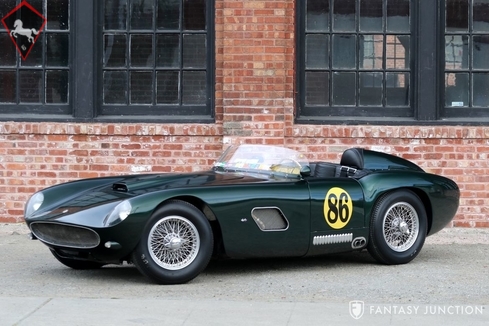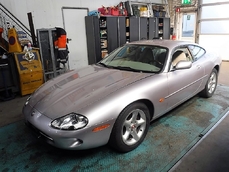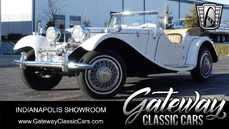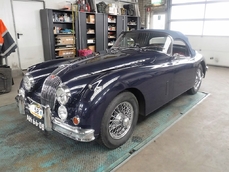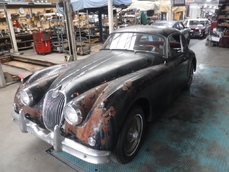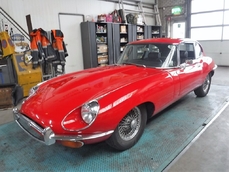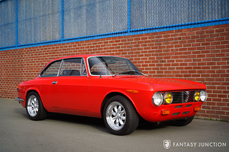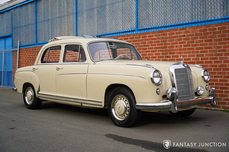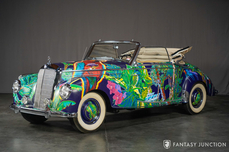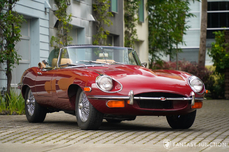Jaguar Other 1955
General description :
1955 Hagemann-Jaguar Special
ID# 27037641
British Racing Green with Black Interior
The 1950s was among the most exciting decades for sports car development. All over the world, companies were building amazing sports cars, competing in races, and advancing performance technology faster than fabricators could build the cars. Not only were major manufacturers competing against each other, but independent builders, cottage industries, and small motorsports start-ups were also innovating, often times with nothing more than a shoestring budgets, grit, and determination to challenge the big guns. Driven hard, modified as new ideas emerged, and often dismantled as their platforms aged, many of these sports racers were lost to history, languished by time, significantly modified, or sadly discarded. Occasionally, however, a unique and important car with competition history and known provenance survives, revealing not only a story of intrepid origin, but dedicated long-term ownership as well. Such is the case with the one of a kind Hagemann-Jaguar Special. Babe Sulprizio was no stranger to mechanical innovation. Having settled in Northern California by the 1950s, he was smitten by mechanical objects and driven to run his own company. By 1954 Sulprizio owned and operated San Leandro, CA based United Engine & Machine Shop and Silva-Lite Piston Company. Eager to compete in the growing Northern California racing scene, Sulprizio realized there was no chance he could afford his most desired car, a C-Type Jaguar, so he put his passion and machining skills to work. By early 1955, construction began using a welded tubular steel ladder frame with Jaguar Mark VII independent front suspension and longitudinal torsion bars up front, with a solid rear axle, longitudinal torsion bars, and a transverse link for the rear suspension. Originally specified to house the all-new Chevrolet 265 V8 engine, the local Oakland Chevrolet assembly plant refused to sell the engine as a separate unit, leading Sulprizio to his second choice, a GMC 302 inline 6. Sulprizio then loaded his chassis and hand sketches for delivery to expert body fabricator and legendary builder Jack Hagemann. After some discussions regarding the details and specifications, Hagemann formed the alloy body panels using traditional English Wheeling and hand panel shaping to build the unique body. Upon completion, Hagemann suggested a polished aluminum finish, but Sulprizio insisted that the car should be painted bright red, leading many who saw the car for the first time to inquire what type of Ferrari it was. Certainly, there was quite a bit of Italian design influence in the forms, Sulprizio himself was from an Italian family, but Hagemann was able to create a unique look for the car. Italianesque from the front, with a wide grille opening, low hood line, and gentle undulation to the rear fenders, with a very characteristically British appearance when viewed from behind. The result was a fresh approach to sports car design, far more advanced than the C-Type Sulprizio had so greatly desired. In its first outing on the track, the GMC engine failed while competing at a race in Stockton, CA Almost immediately, Sulprizio removed it, installing a 3.4 litre Jaguar DOHC in-line six engine removed from an XK120. In 1961, after enjoying the car for several years and racing at various Northern California racetracks, Sulprizio traded the special in on a brand-new Jaguar XKE roadster. For some period of time the Hagemann-Jaguar remained on display at Oakland British Motors until it was purchased by Bill Barrington, who shortly thereafter sold it to Al Bourdet. Typical of the times, Bourdet regarded the special as an enjoyable sportscar, using it to commute between his homes in Berkeley and Squaw Valley. In 1976, Bourdet sold the car to the current owner, beginning an unbroken history of ownership spanning 44 years, preserving and maintaining this rare one of a kind hand-built alloy sports racer. Under the first 20 years of the current owners use, the car was maintained and race-prepared by a cadre of legendary Northern California performance specialists including Ivan Zaremba at Griswold & Co. and then with Phil Reilly. In 1976, after experiencing brake fade only six laps into his first race, the current owner elected to replace the XK120 drum brakes with XK150 disc brakes. During the ensuing years of ownership, the Hagemann-Jaguar Special participated in multiple events, including every Monterey Historic race since 1976, celebrated in colorful glory with an array of event participation stickers spanning nearly two lengths of the low-profile windscreen. Also, during his ownership, the current owner repainted the car in its current and distinctive British-American Racing Green metallic, settling any association with the often-mistaken Ferrari moniker. The current owner also acquired a California DMV issued ID for title and registration. The car is titled in the State of California as a SPCNS (Specially Constructed) with appropriate documentation; however there is no physical stamped ID number or plate on the car.
After thirty years of driving, the current owner invited expert Bernard Juchli to not only prepare the car to high standards, but to also race it in various events. Juchli, having owned and operated a Jaguar restoration and repair shop in Los Gatos, CA and having been a successful racer in his own Jaguar XKE, took the Hagemann Special to the front of the pack, frequently as a class winner in multiple vintage racing events. Juchli, now manager of Jay Leno’s “Big Dog Garage”, often displayed the car at Leno’s Burbank, Ca. location as well as featuring it with Jay driving in one of his “Jay Leno’s Garage” videos. Among the many improvements this wonderful car has seen over the years, the current engine installed in the car is a 4.2L unit which dyno tested at around 400hp. The engine was built with Carrillo Rods, Cosworth pistons, a big valve head, and 13:1 compression ratio. Likely in need of detuning in order to run on 91 octane fuel, the engine is built for racing purposes and would very likely benefit from a rebuild in the near future. Over the years, the consummate preparation, careful performance tuning, and ongoing enjoyment of this rare car has been carefully chronicled by 44 years of dedicated and unbroken ownership. Today, this beautiful and unique car presents in very nice condition with good cosmetics throughout. The quality of the finish is in keeping with enjoyable race car cosmetics with glossy paint and appropriate detailing, though some areas show more evidence of use and general wear. The subtle metallic deep green paint is an excellent choice for the car, giving it a sinister profile, touched off by a set of beautifully polished Borrani alloy wire wheels shod with Dunlop racing tires. The profile of the car is pure and clean, featuring covered headlights, a floating hood, performance intake scoop, and a polished aluminum outside filler cap. The quintessential touches of period racing; riveted head fairing, side vents, rocker louvers, and side exit exhaust, are all perfectly executed as balanced details without being visually distracting as often seen on many vintage racecars. The exterior finish captures the fluidity of the undulating fender lines showing just a few chips in some closure areas and evidence of road use, all of which confirm years of documented and enjoyable ownership. The hand formed aluminum body still exhibits expert contours and fluid reflections stretching out over the wide, low body. The large wheels and tires fill the wheel openings with just the right amount of presence to give the car a powerful and eager stance. Every view of the car is a testament to the capabilities of Hagemann and the vision of Sulprizio. Accenting the hood, a fitting Jaguar emblem resides at the center, while the rear of the car features a 1955 California year of manufacture license plate. Inside the cockpit, a prominent array of period correct instruments, toggle switches, and wood rimmed steering wheel delight the viewer with authority and detail. The aluminum formed dashboard blends smoothly into the upper door surfaces, hollowed out to yield lighter construction. The interior seating materials are reminiscent of the pattern and design seen in the Jaguar XKSS, supported by modern Deist racing seatbelts, carpeted floors, and a low-profile plexiglass windscreen. Flanking the smaller instrument cluster, an historic badge indicates the origin of construction “Built by Hagemann Special Cars”.
The engine compartment has been thoughtfully and accurately prepared with a very purposeful appearance, representative of vintage Jaguar features. The triple Weber carburetors breathe through six polished trumpets feeding into a polished intake manifold, topped by polished aluminum cam covers and traditional gold painted head valley. The beautifully formed and hued tuned exhaust headers snake the sidewall of the engine compartment where they collect, exiting beneath the driver’s side of the car. The engine compartment has been finished with turned aluminum cowl and inner fender panels, echoing the traditions of great racing cars and aircraft cowling. The underside of the car reveals the original construction of the tubular frame and various support structure, mercifully retained while combined with updated features as needed.
Stepping into the car and firing up the engine, a powerful burst of energy erupts as the car comes to life, revealing its competition lineage. The engine settles into a throaty idle with just enough thumping resonating in your chest. On throttle, the car is a monster of power and torque, yet balanced for skilled drivers. The engine, even lightly on song, aided by the light flywheel, pulls wonderfully under tight throws from the 5-speed gearbox. The tall, firm brake pedal offers confident stopping, and the taut suspension coupled with the low center of gravity make this car simply wonderful to drive. Very well sorted for street use and certainly capable of running at the head of the pack against nearly anything built in this period, the Hagemann-Jaguar Special is a delight in every respect. While this car has been professionally maintained to high quality standards, we strongly encourage a comprehensive pre-event review with a professional racing preparation shop prior to use. Included with the car is a 9.5:1 compression ratio 3.8L engine which was previously installed and is more street-friendly but will need to be rebuilt. Also included are a 4-speed all synchromesh Jaguar gearbox, a softer pair of front torsion bars, a box of miscellaneous track-related spares and copies of the logbooks that document many of the races supporting the history of this car.
A unique and recognized participant in numerous premier vintage racing events, this wonderfully conceived and thoughtfully curated sports racer is ready to deliver the next fortunate owner the same pride of ownership the current owner has enjoyed for the past 44 years. With historic importance, sorted mechanicals, and stunning design, the 1955 Hagemann-Jaguar Special offers all the excitement and excellence of a handcrafted performance sports racer from the glory days of sports car racing.
Please note: The Hagemann-Jaguar Special is titled in the State of California as a SPCNS (Specially Constructed) vehicle, first sold in 1959, but without a year or year of model indicated.
https://fantasyjunction.com/inventory/1955-hagemann-jaguar-special-1/overview
1955 Jaguar Other is listed sold on ClassicDigest in Emeryville by Fantasy Junction for Not priced.
Car Facts
Car type : Car Make : Jaguar Model : Other Engine size : 4.2 Model Year : 1955 Location : Emeryville Vehicle Registration : Normal
Sold
Seller Information
Sold
People who viewed this Jaguar Other also viewed similar Jaguar listed at ClassicDigest
Other cars listed for sale by this dealer
About Jaguar
Ah, the story of Jaguar, from its early days as the SS Cars Ltd. to its pinnacle with the D-type, and the street-going evolution in the form of the iconic E-type. There's something quintessentially British about this tale, and I'll narrate it as a British journalist might.In the Beginnings:
Our journey into the world of Jaguar begins in the 1930s, when a company known as SS Cars Ltd. emerged. Despite the unfortunate coincidence of their initials with the rising political tensions in Europe, they started producing stylish and performance-oriented cars. The SS 100, introduced in 1936, was a symbol of elegance and speed, setting the stage for what would become Jaguar.
The Birth of Jaguar:
As the shadows of World War II loomed, SS Cars Ltd. wisely decided to disassociate themselves from the SS initials. Thus, in 1945, they officially became Jaguar Cars Ltd., a name that would soon be synonymous with British luxury and performance.
The XK Series:
Jaguar's post-war era brought us the XK 120, a true sensation in 1948. With its sleek design and a powerful 3.4-liter inline-six engine, it became the world's fastest production car. The XK 120 was the blueprint for what lay ahead – Jaguars that blended style with speed in a uniquely British fashion.
The D-type Dominance:
Then came the D-type, a true racing legend. Introduced in 1954, it won Le Mans three times in the 1950s, showcasing Jaguar's engineering prowess. With its innovative monocoque construction and the iconic fin at the back, the D-type was the apex of Jaguar's motorsport success.
The E-type Emergence:
But the true turning point arrived in 1961 with the introduction of the E-type, often described by Enzo Ferrari as "the most beautiful car ever made." Its long bonnet, curvaceous body, and a 3.8-liter engine delivering exhilarating performance made it an instant classic. The E-type was not just a car; it was a work of art on wheels, and it could hit 150 mph on the road.
Street and Racing Success:
The E-type's beauty was matched by its capability on the track. The lightweight E-types were particularly successful in various racing events, cementing Jaguar's reputation as a force to be reckoned with in motorsport.
The Age of Refinement:
As we delve deeper into the Jaguar story, we find that the 1950s and 1960s were an age of refinement and expansion. Alongside the magnificent D-type and the E-type's iconic emergence, Jaguar introduced models that further solidified its reputation for luxury and performance.
The MK2:
In the late 1950s, Jaguar unveiled the MK2, a sports sedan that combined elegance with power. This sleek four-door saloon was a favorite of bank robbers and law enforcement alike, thanks to its exceptional speed and handling. The MK2 was a symbol of Jaguar's ability to blend sophistication with performance and had a successful racing career as well.
The XJ6:
Fast forward to 1968, and Jaguar launched a car that would define luxury saloons for decades to come – the XJ6. It was a masterpiece of engineering and design, featuring a smooth inline-six engine, independent rear suspension, and a spacious, beautifully appointed interior. The XJ6 was a symbol of British elegance and provided a ride so smooth that it seemed to glide over the road. It became the flagship model for Jaguar and set the standard for luxury saloons, showcasing a level of refinement that left competitors in awe.
The Blend of Classic and Modern:
While the MK2 and XJ6 represented the evolution of Jaguar's saloon cars, they maintained the brand's commitment to performance and luxury. These cars didn't just belong on the racetrack; they were equally at home cruising down the grand boulevards or gliding through the English countryside.
The Challenges of Change:
However, as the 1970s arrived, Jaguar, like many British automakers, faced financial challenges and changes in ownership. The British Leyland era brought both opportunities and struggles, as the brand navigated through various mergers and transitions.
Nevertheless, the legacy of the MK2 and XJ6, along with the D-type and E-type, continues to define Jaguar as a manufacturer that combines timeless elegance with a spirit of performance. These classic models, whether driven on winding roads or parked as collectors' treasures, serve as a testament to Jaguar's enduring presence in the world of automotive excellence.
The Jaguar story, from its early days as SS Cars Ltd. to the creation of automotive icons like the E-type, MK2, and XJ6, is a journey that reflects the very essence of British motoring – a blend of luxury, power, and style that continues to captivate enthusiasts and connoisseurs alike.
